Creative Bathroom Counter Backsplash Ideas That Shine
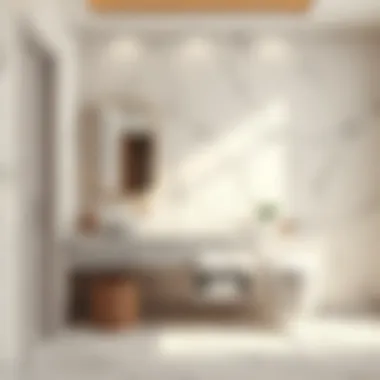
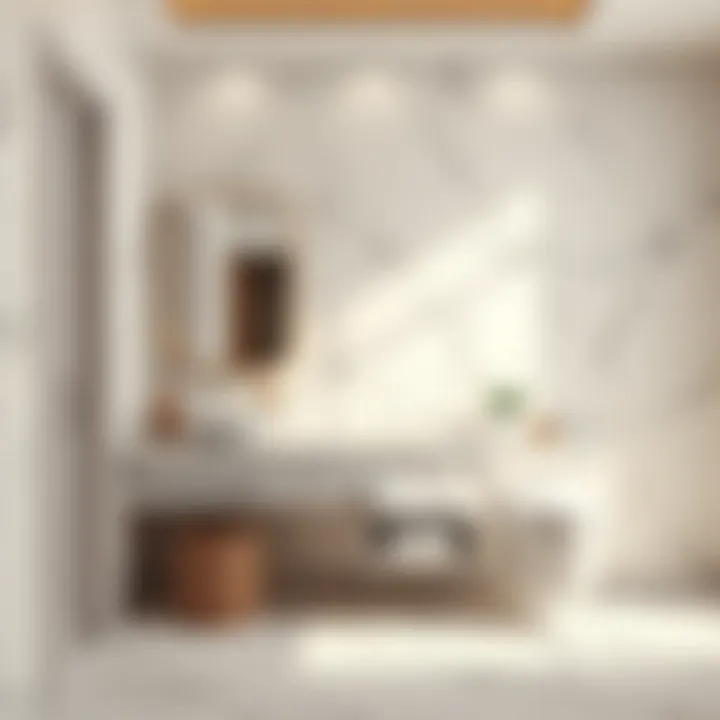
Intro
Bathroom counters are more than just functional spaces; they can also serve as stunning focal points. The backsplash, often overlooked, acts as a bridge between utility and design within this private sanctuary. Gone are the days when backsplashes were merely tiles arranged in a straight line. Today's trends invite creativity, encouraging homeowners to experiment with materials, colors, and styles that reflect their personal taste.
When considering your bathroom counter backsplash, the options seem nearly endless. Marble whispers elegance, while colored glass can shout modernity. Choosing the right backsplash is like selecting an accessory for an outfit; it completes the overall aesthetic and enhances the character of the space. It's an opportunity to express creativity, and it’s vital for creating a serene atmosphere amidst the daily grind.
In this article, we’ll explore current trends in bathroom counter backsplashes, sophisticated yet practical design choices, and a gallery of inspiring ideas. Whether you’re in the market for an overhaul or just seeking a refreshing touch, you’re bound to find something to ignite your imagination.
Understanding the Importance of a Backsplash
A bathroom backsplash is more than just a decorative element; it serves as a crucial component that impacts both the functionality and the visual appeal of the space. In many households, the bathroom is often the first place to encounter water, steam, and various forms of cleaning products. Therefore, having a reliable and stylish backsplash can significantly enhance the durability and aesthetic of this frequently used area. Understanding the importance of a backsplash is vital for homeowners who wish to marry beauty with practicality in their bathrooms.
Functional Benefits
When it comes to functionality, a backsplash plays a key role in protecting your walls from potential water damage and stains. For instance, if water splashes onto the wall while washing your hands or brushing your teeth, a properly installed backsplash can act as a barrier. This is particularly useful in spaces where tiles or panels are used, as they can resist moisture and are easier to clean compared to wall paint.
- Protection: The foremost function of a backsplash is protection. It can prevent mold and mildew from infiltrating your walls.
- Ease of Cleaning: Unlike traditional paint or wallpaper that might absorb moisture, a well-chosen material like ceramic or glass can be wiped down with ease, making maintenance a walk in the park.
- Durability: Materials like porcelain and stone offer long-lasting durability that ensures your backsplash withstands everyday wear and tear.
Let's not forget that functionality also touches on the practicality of installation and upkeep. With various materials available, homeowners can often opt for options that suit their time constraints and DIY capabilities. Investing time in choosing the right backsplash can translate into a long-term payoff.
Aesthetic Enhancement
On the other side of the coin, the aesthetic enhancement a backsplash brings to a bathroom can’t be overstated. It can serve as a focal point that ties the entire room together and reflects personal style. Whether you prefer modern minimalist vibes or rustic charm, the options are nearly endless.
A backsplash can create visual interest and depth, especially if composed of unique patterns or colors. Consider the range of possibilities—from subway tiles with a glossy finish to intricate mosaic layouts. Here are some elements to consider:
- Color Coordination: Picking a tile that complements your existing color palette can dramatically alter the vibe of your bathroom. A soft blue backsplash can enhance a coastal theme, while bold black tile may introduce a touch of elegance.
- Textured Finishes: Textures can elevate your backsplash from mundane to mesmerizing. A 3D panel, for example, can catch light and create shadows, enhancing the mood of the room.
- Reflective Surfaces: Glass or glossy tiles can reflect light, making small spaces appear larger and brighter, adding a sense of openness.
"A well-designed backsplash not only offers safeguarding against water but enhances the visual narrative of your bathroom."
By considering both functional and aesthetic aspects, homeowners can elevate their bathrooms into much more than mere utility spaces. Instead, a cleverly chosen backsplash can transform a simple bathroom into a serene sanctuary, making it both practical and peaceful.
Material Selection for Backsplashes
Choosing the right materials for your bathroom counter backsplash is a pivotal step in achieving a perfect blend of practicality and style. The right materials can transform not only the aesthetics of the space but also enhance its functionality. In this section, we’ll delve into various materials available for backsplashes, dissecting the specific elements that contribute to their popularity and suitability.
Ceramic and Porcelain Tiles
Durability
Durability is one of the key traits of ceramic and porcelain tiles, making them a favored choice among homeowners. These tiles are renowned for their ability to withstand moisture and humidity, which is crucial in bathroom settings. Unlike other materials that can rot or warp, ceramic tiles resist these issues effectively. This high resistance means less worry about wear and tear over time, making the initial investment worthwhile. A unique feature of their durability is that they hold up against daily cleaning without losing their shine or integrity.
However, while they are tough, ceramic tiles can chip or crack if heavy objects are dropped on them. Thus, it's wise to handle them with care during both installation and day-to-day use.
Versatility
Versatility is perhaps another strong suit of ceramic and porcelain tiles. They come in a myriad of colors, styles, and patterns, giving plenty of room for creativity. Homeowners can find everything from classic white subway tiles to intricate decorative designs, allowing them to craft the bathroom look they desire. The ability to mix and match tiles adds to their appeal as different colors and patterns can help create unique visual stories.
Nonetheless, if you're looking for something that stands out with a more natural feel, the uniformity of ceramic can be a downside for some. It's essential to weigh this against the desire for a cohesive design aesthetic.
Glass Backsplashes
Visual Impact
Glass backsplashes boast a striking visual impact, bringing a modern and sleek touch to bathroom spaces. Characterized by their reflective surfaces, glass tiles can make a small bathroom feel more expansive. This reflective property is particularly advantageous in a space that often lacks natural light. The ability to catch and reflect whatever little light there is can make a significant difference in ambiance.
On the flip side, glass can be more susceptible to scratches and fingerprints, which might detract from their allure if not maintained properly. Homeowners must be diligent about cleaning to keep them looking pristine, but the trade-off is often worth the dramatic enhancement in style.
Ease of Cleaning
When it comes to ease of cleaning, glass backsplashes truly shine. Their smooth surface does not harbor grime like textured materials do, leading to quick cleaning with just a bit of soap and water. This aspect is particularly appealing for busy households where time is of the essence. The non-porosity of glass also means no staining from soap scum or hard water—an added benefit in bathrooms.
However, it’s worth noting that the installation can be a bit tricky, and may require a professional touch to avoid damage. But the reward is a stunning, easy-care backsplash that complements many styles.
Natural Stone Options
Granite
Granite stands tall among natural stone options, typically celebrated for its robust nature. This material not only adds luxury but also has an impressive resilience to scratches and heat. Such characteristics make granite an ideal choice for homeowners looking for durability in addition to beauty.
However, the main downside is the maintenance requirements; granite does need regular sealing to maintain its resistance to stains. It offers a rich, unique look with each slab, but this uniqueness comes with a price tag; quality granite can be among the more expensive backsplash materials.
Marble
Marble’s timeless beauty is its primary draw. Known for its veins and patterns, it brings a sense of elegance that can elevate the entire bathroom. Its luxurious appeal often makes it the choice for those looking to create a high-end space.
Nevertheless, marble is softer than granite, making it more prone to etching and stains. Regular upkeep and the right treatments can help mitigate these issues, but they come at the cost of added care and maintenance.
Quartzite
Offering a unique mix of beauty and durability, quartzite is another natural stone that deserves mention. It carries the elegance of marble but is much tougher, making it less porous. This means it’s less likely to stain or require sealing compared to its marble counterpart.
The trade-off is that while quartzite offers many benefits, it often comes at a higher price point, similar to that of granite. Still, for homeowners willing to invest, quartzite can provide a polished look that stands the test of time.
Wood Accents
Warmth and Texture
Wood accents can introduce warmth and texture to a bathroom, elevating the emotional appeal of the space. Incorporating wood into your backsplash brings a natural element that can soften the often sterile look of tiles and stone. This touch is especially inviting in bathrooms designed to evoke a spa-like feel.
However, wood does come with considerations. Exposure to moisture can lead to warping or deterioration unless proper treatments are applied. Thus, it’s best used in controlled applications or combined with protective finishes for the longevity of the material.
Maintenance Considerations
When it comes to maintenance, wood backsplashes require a bit more attention. They might need frequent sealing or treatment to ensure they remain resistant to moisture, especially in a humid environment like a bathroom. While the aesthetic benefits are undeniable, weighing the upkeep demands against the desired look is crucial.
Homeowners might find that opting for wood on a smaller scale, such as accent strips or smaller areas, can provide the desired effect without overwhelming maintenance tasks.
Choosing the right material is not just about aesthetics; it’s about finding the intersection of beauty, durability, and upkeep requirements that fit your lifestyle.
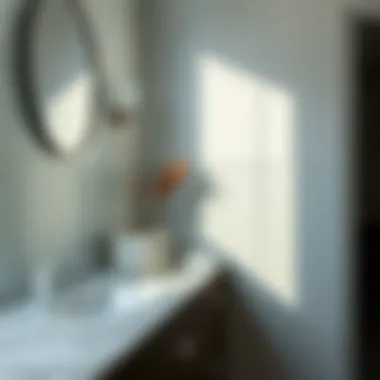
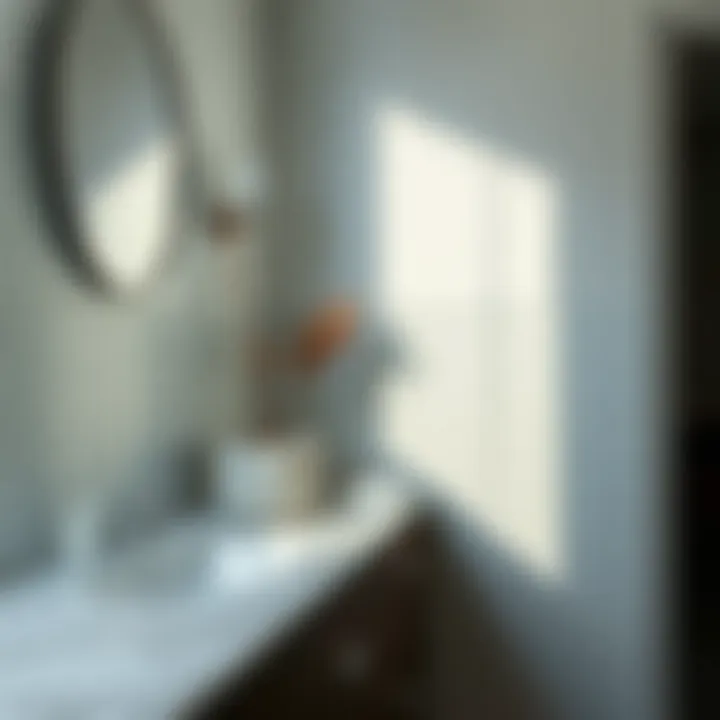
Selecting materials for bathroom backsplashes is an intricate dance of balancing aesthetic desires with practical needs. Ensuring the functionality of the materials chosen will not only enhance the bathroom's beauty but also its overall efficiency and longevity.
Color Choices for Backsplash Design
Choosing the right color for your backsplash is crucial, not just for aesthetics but also for creating an overall ambiance in the bathroom. The splash of color you choose can greatly affect the mood of the space, influencing the feeling of serenity or vibrancy. Ultimately, it reflects personal style and ties in with the rest of your home design.
A well-selected color scheme can enhance the functionality of a room too. It helps in creating a cohesive look when combined with the countertops and cabinets. With countless options available, deciding on the right hue requires careful consideration of various elements such as lighting, other material choices, and the desired emotional impact.
Neutral Palettes
Beige and Cream
Beige and cream are classic color choices for a backsplash in a bathroom. Their soft, understated tones are appealing to many because they create a calm and tranquil environment, which is just what most look for in a bathroom.
The versatility of beige and cream allows them to act as a perfect canvas for other colors or materials in the bathroom. They can seamlessly blend with wooden fixtures, chrome accents, or even vibrantly colored decor. Their ability to reflect light gives rooms an airy feel, making small spaces appear larger.
Yet, one might find that beige and cream can sometimes lack character if used excessively. A bathroom splashed only with these hues may seem bland. Finding the right balance by incorporating textured materials or contrasting accents can solve this.
Gray Variations
Gray has become a staple in modern design, and for good reason. Its varying shades—from light silver to deep charcoal—offer a range of options that can bring depth and sophistication to a bathroom environment.
Gray is reminiscent of natural stone and pairs exceptionally well with both minimalistic and rustic aesthetics. The neutral characteristic of gray allows it to complement many styles while providing a sense of calm. It also does not easily show water spots or stains, which is often seen in lighter colors.
However, if used without care, gray can make a space feel too cold or sterile. It’s essential to incorporate warmer elements, whether through wood accents or warmer-colored appliances, to maintain a welcoming atmosphere.
Bold Colors
Deep Blues
Deep blues can inject a sense of luxury into your bathroom backsplash. This color often evokes tranquility and depth, much like the ocean or twilight sky. The rich tones can create a striking focal point, especially when combined with lighter fixtures or minimalist decor.
The appeal of deep blues lies also in its versatility. It pairs wonderfully with white or neutral cabinetry, bringing a modern touch to traditional designs. A deep blue backsplash can help to ground a light-colored space, providing visual interest without overwhelming the senses.
Nevertheless, too much of this bold color can easily darken a space. When opting for deep blues, consider balancing them with light tones to ensure the room still feels open and inviting.
Rich Greens
Rich greens have surged in popularity, reflecting nature’s calming influence right in the bathroom. This color can range from forest hues to emerald tones, reminiscent of lush landscapes. It establishes a peaceful retreat, making it ideal for a space designated for relaxation.
When used wisely, rich greens can lend a touch of elegance and opulence to the bathroom area. They offer refreshing contrast against white fixtures while also adding warmth to darker cabinetry. However, care must be taken, as these hues might quickly dominate if overdone. Using accents or complementary colors can make the overall look harmonious.
Fiery Reds
Fiery reds serve as a bold statement, adding a splash of energy and passion to your surroundings. This color can create an invigorating atmosphere and can be particularly striking in a bathroom designed to be a personal oasis.
The unique feature of fiery reds is their ability to capture attention and evoke emotion. Complimenting these vivid tones with subtle grays or whites can tone down the intensity, maintaining balance while keeping the space lively. However, using too much red can often feel chaotic, so moderation and careful integration are key.
Monochromatic Schemes
Monochromatic schemes offer a unique approach to color choices for backsplashes. By utilizing varying shades of a single color, these designs create a harmonious and cohesive look that can easily adapt over time. This method simplifies the palette, allowing for greater flexibility in selecting materials and textures that complement one another.
In addition, a monochromatic scheme can help articulate the bathroom’s features distinctly, enhancing visual appeal while minimizing clutter. The key is to apply different finishes and textures to maintain interest in the design, ensuring that even a single color is engaging enough to catch the eye.
Design Patterns and Layouts
When it comes to bathroom design, the backsplash isn't just a functional component; it also sets the tone and style for the whole space. Design patterns and layouts play a pivotal role in achieving that desired aesthetic. Selecting the right arrangement can transform a mundane area into a captivating visual experience.
Employing distinct patterns can emphasize certain features, create a sense of movement, or even enlarge the perceived space. Homeowners should consider each layout as part of a larger design narrative, ensuring that their choices reflect their personal taste and harmonize with the rest of the decor. With the right patterns, a small bathroom can feel more expansive, while a larger one can become strikingly intimate.
Subway Tile Arrangements
Subway tiles have remained a favorite for years due to their simple elegance and versatility. Typically rectangulated, these tiles allow for numerous arrangement options that can dramatically change the overall look of a bathroom.
- Standard Orientation: The classic horizontal stack is timeless and straightforward. This orientation not only makes a space appear wider but also offers a clean and chic aesthetic.
- Vertical Stacking: This layout can really elevate the design, drawing the eye upwards. It often works wonders in smaller spaces, making ceilings look taller.
- Offset Pattern: Staggering tiles in a grid format creates interest while maintaining an organized look. This layout is both pleasing to the eye and practical, making any bathroom look polished.
Subway tiles, with their smooth glaze, are easy to clean, which is a crucial benefit in high-moisture areas.
Mosaic Designs
Mosaic backsplashes introduce a splash of dynamism and creativity into bathroom spaces. These intricate designs can be made from various materials such as glass, ceramic, or stone, and are available in a wide array of colors and patterns.
- Intricate Scenes: For those looking to make a bold statement, custom mosaics can tell a story or showcase themes like nature or geometric shapes. This type of design can transform the small space above the sink into a focal point.
- Color Play: Mixing different colors not only adds liveliness but can cleverly incorporate the bathroom's color scheme. Incorporate soft pastels or bright hues depending on the mood and style.
- Textures: Some mosaics come in various textures—think shiny glass versus textured stone—allowing for a multi-dimensional design that invites touch and interest.
With mosaics, homeowners can let their creativity run wild, crafting a unique splash that reflects their individuality.
Diagonal and Herringbone Patterns
Diagonal and herringbone patterns bring bold energy to the backsplash, allowing homeowners to step out of the bounds of conventional design. These layouts demand attention and can serve as stunning visual anchors in a bathroom.
- Diagonal Layout: Laying the tiles at angles can create a dynamic flow and attract the eye throughout the space. This method can make square tiles feel more elongated, effectively changing the perception of dimensions.
- Herringbone Style: Known for its chevron-like look, the herringbone layout combines sophistication with a modern twist. It can be effective in both contemporary and more classic settings. The interlocking shapes create rhythm and visual interest, making it a timeless choice.
Both diagonal and herringbone patterns require more planning during installation but can yield results that are nothing short of spectacular.
"The right design pattern can turn even the simplest tile into a work of art, narrating a story of style and personal expression."
Incorporating Texture into Backsplashes
Adding texture to bathroom backsplashes is more than just an aesthetic choice; it's a way to elevate the entire space into something unique and captivating. Texture can provide depth, creating visual interest that captivates the eye and breaks the monotony of flat surfaces. In the realm of bathroom design, where functionality meets style, textured backsplashes offer homeowners an opportunity to showcase their creativity while enhancing practicality.
Benefits of Incorporating Texture
One of the primary advantages of texture is its ability to catch light in various ways, offering a play of shadows that changes throughout the day. This dynamic effect can make a bathroom feel more inviting and layered. Additionally, textured backsplashes can hide minor water spots and stains better than flat finishes, which is invaluable in the humid atmosphere of a bathroom. They also serve as a conversation starter, allowing homeowners to express their personality through unique designs.
Some points to consider when incorporating texture are:
- Safety: When choosing textured materials, ensure they are safe when wet. Some textures might become slippery, posing a hazard.
- Scale and Proportion: Larger textures can overpower a small bathroom and make it feel cramped. Choose wisely according to the size of your space.
- Color Coordination: Textured materials can influence color perception, so consider how the texture changes with light when paired with colors.
Textured Tiles
Textured tiles have been a staple in interior design for ages. Their versatility allows for a range of effects, from rustic to modern. Whether you choose a patterned ceramic tile or a slate with natural variations, the options are endless.
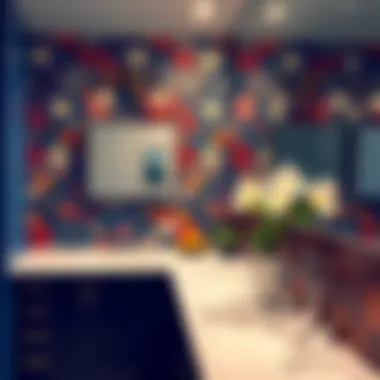
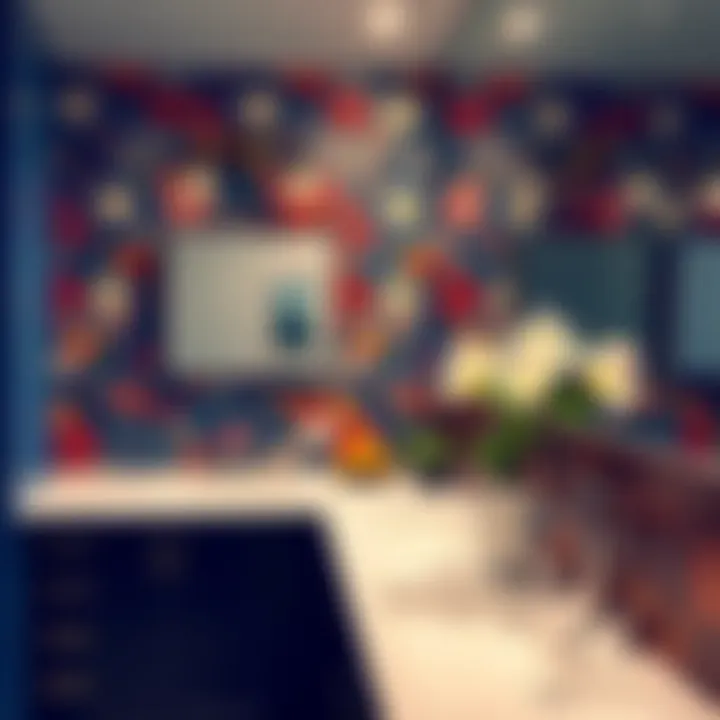
The Beauty of Variety: One could argue that textured tiles are incredibly adaptable. For instance, thinking about using large ceramic tiles with an intricate pattern can transform a simple space into something sophisticated. On the other hand, rough-hewn stone tiles bring an earthy charm that can complement well-designed vanities.
Unique Patterns: Patterns such as ribbed, wavy, or embossed can add not just texture but also artistic flair. They can draw attention to a minimalistic countertop or provide balance to intricate bathroom hardware.
"A textured tile ensures that no two finishes are identical, revealing the artistry baked right into the material itself."
3D Panels
3D panels are amongst the newer innovations in backsplash design. Made from various materials, including PVC, wood, and ceramics, these panels can create astounding visual impressions with their three-dimensional surfaces.
Creating Depth: The protruding and recessed areas can bring about a sense of movement and life onto what might otherwise be a dull wall. For example, a panel with geometric designs can add a contemporary touch while hiding the wear and tear that comes from daily use.
Installation and Maintenance: One of the aspects that appeal to many homeowners is the relatively straightforward installation process of 3D panels. Most panels can be adhered with adhesive, making the project accessible for DIY enthusiasts. As with any texture, maintenance should be kept in mind; choose materials that are easy to wipe down to maintain their charm and cleanliness.
In summary, incorporating texture into backsplashes can significantly transform a bathroom's character. Textured tiles and 3D panels offer unique possibilities, blending beauty with functionality to create a stunning and practical bathroom environment.
Eco-Friendly Backsplash Options
Choosing a backsplash for your bathroom isn’t just about aesthetics or functionality. It's about making a responsible choice too. Eco-friendly backsplashes are gaining traction among conscious homeowners. Not only do they help in reducing one’s carbon footprint, but they also enhance the overall health of your living space. When you select environmentally friendly materials, you are contributing to a healthier planet while still achieving an elegant look in your bathroom.
Before diving into specifics, it’s essential to understand that eco-friendly materials can be remarkably versatile. They aren’t limited to a bland, earthy aesthetic. In fact, many green options boast unique finishes and styles that can elevate any bathroom design. Here we'll explore options that resonate with sustainability while being visually striking and practical.
Recycled Materials
Recycled materials are a fantastic choice for those looking to add a unique touch to their bathroom. Products made from reclaimed or reused items not only reduce waste but also create a rich narrative within your design.
- Variety of Sources: You can find recycled glass, metal, and even tile options. For example, recycled glass tiles can present a mosaic of colors, fitting right into your stylistic vision while keeping the environment in mind.
- Durability and Maintenance: Often, materials like recycled glass are as sturdy as their non-recycled counterparts. They can withstand moisture and offer easy cleaning solutions. It’s a win-win situation; you keep your bathroom looking sharp with less effort.
"Recycled materials tell a story. Each piece reflects a journey, making your backsplash not just a decor but also part of a larger narrative."
When choosing recycled materials, scrutinize the producer and their sourcing methods. Inspect if their process truly contributes to sustainability. Also, ensure the materials are safe for indoor use, as some might not adhere to stringent health regulations.
Sustainable Wood Choices
While wood is often overlooked in wet spaces, sustainable wood options can add warmth and character to your bathroom backsplash.
- Types of Wood: Bamboo is a popular option, thanks to its rapid growth and renewability. Other sustainable woods include cork or reclaimed wood from old buildings. These materials provide both sturdiness and charm to your backsplash design.
- Finishing Touches: Proper sealing is critical for wooden backsplashes to endure moisture. Choosing eco-friendly sealants can further enhance your commitment to sustainability while protecting the wood from damage.
When opting for wood, consider how it complements your existing elements. A rich walnut wood against bright tiles can create a striking contrast that is hard to beat.
Installation Techniques
When diving into the renovation waters of your bathroom, the installation techniques you choose for your backsplash can make or break the whole project. Not only do effective methods ensure that the beautiful, ideal look is achieved, but they also guarantee longevity. A kitchen or bathroom backsplash is exposed to moisture, heat, and various cleaning agents, so a sturdy installation must be prioritized.
Let’s explore two primary paths homeowners may consider: DIY installations and hiring a professional. Each approach has its unique advantages and requires different levels of effort and expertise.
DIY Installation Steps
If you fancy yourself a bit of a do-it-yourself aficionado, tackling a backsplash installation can be quite satisfying. Here’s a straightforward guide to get you started:
- Gather Your Tools: First off, you’ll need essentials like a level, tile spacers, a notched trowel, a tile cutter, adhesive, and grout. Having everything ready will prevent any donkey work during the installation.
- Prepare the Surface: Clean the wall where the backsplash will go. Any dust, grease, or old adhesive needs to be removed to ensure a strong bond.
- Measure and Mark: Using a level, draw a line where the top of the backsplash will sit. This will act as a guide to keep your tiles straight like an arrow.
- Apply Adhesive: Spread adhesive onto a small section of the wall with your notched trowel. This prevents the adhesive from drying out too fast.
- Place Tiles: Begin laying your tiles, inserting spacers between them to create even gaps for grout. Keep checking with your level, as small misalignments can lead to bigger headaches.
- Grout the Tiles: Once the adhesive is dry, mix and apply grout, scraping away excess with a grout float. Wait for it to set up before cleaning the surface with a damp sponge.
- Seal the Grout: To prevent moisture from seeping in, apply a sealant after the grout has completely cured.
This approach allows for considerable creativity and personalization. However, remember that patience is key!
Hiring a Professional
Sometimes, the best decision is to take the back seat and let the experts handle it. Hiring a professional can offer peace of mind and often ensures a finer finish, especially if the design is complicated or if time is of the essence. Here are some considerations:
- Experience Matters: Professionals have the skills, experience, and tools to handle various materials and designs. They've likely tackled pressure areas that an amateur might overlook.
- Design Guidance: When working with pros, they might suggest ideas and styles that align with current trends or offer alternatives that you hadn't considered.
- Time-Saving: Letting professionals take care of the installation frees up your schedule. If you’re busy juggling family and work duties, this could be a game changer.
- Warranty and Assurance: Many installation services offer guarantees or warranties on their work. If any issues arise post-installation, you have the backup you need without having to put on the thinking cap.
In the end, whether you fly solo or enlist a hired hand boils down to your comfort level, skill, and time constraints. Making your choice judiciously can lead to a splendidly styled bathroom that feels as good as it looks.
Maintaining Your Backsplash
Keeping your backsplash in tip-top shape is crucial for both its appearance and functionality. A well-maintained backsplash can enhance the overall kitchen or bathroom aesthetic while preventing long-term damage. When you invest time and effort into cleaning and safeguarding this important design element, you not only prolong its life but also ensure that it continues to elevate your space for years to come.
Regular maintenance can save you from costly renovations down the line. The accumulation of grime, soap scum, or water stains could dull its appearance, making it look worn and tired. By adopting effective maintenance strategies, you can keep your backsplash looking as fresh as the day it was installed.
Let’s slip right into the nitty-gritty of how to maintain it properly.
Cleaning Techniques
To keep a backsplash spick and span, you'll need to incorporate a solid cleaning routine. Here are some effective techniques:
- Gentle Detergents: For routine cleaning, mix warm water with a mild dish soap. Use a soft sponge to wipe down the surface. Avoid abrasive pads that might scratch it.
- Vinegar Solution: A mixture of equal parts vinegar and water makes for a natural cleaner that can tackle stubborn stains on ceramic or glass backsplashes. Just spray it on and wipe it off!
- Baking Soda Paste: When faced with tough stains, make a paste with baking soda and water. Apply it to the spot, let it sit for a bit, then scrub gently with a soft cloth.
"An ounce of prevention is worth a pound of cure." Keeping a scheduled cleaning routine helps maintain your backsplash's luster.
Preventing Damage
Aside from cleaning, preventing damage is equally critical. Here are some considerations to protect your backsplash:
- Immediate Spill Clean-Up: Don’t let spills sit. Wipe up water or cleaning solutions right away to avoid staining, especially on porous materials like natural stone.
- Use Trivets and Hot Pads: Protect your backsplash from heat by using trivets for hot pots or pans. This practice not only keeps your backsplash safe from thermal damage but also adds to the overall decor.
- Sealants for Natural Stone: If you opted for natural stone like granite or marble, ensure you're applying a sealant every so often to prevent stains and moisture penetration.
By focusing on these cleaning techniques and damage prevention tips, maintaining your backsplash becomes a manageable task. Your bathroom or kitchen will thank you for it through its continued beauty and functionality.
Trends in Backsplash Design
The design of your bathroom backsplash can significantly influence the overall look and feel of the space. Trends in backsplash design encompass various elements that adapt to changing tastes and lifestyle needs. Keeping up with these trends is not just about aesthetics; it also involves crafting a practical sanctuary that reflects your personality and meets your daily requirements. By understanding these trends, homeowners can make informed decisions that ultimately elevate their bathroom experience.
Minimalist Aesthetics
Minimalism as a design philosophy has gained traction in recent years. It focuses on simplicity, functionality, and clean lines. When it comes to bathroom backsplashes, this translates to the use of solid colors and straightforward materials. Think about using white subway tiles or matte finishes that create a sense of calm and spaciousness in your bathroom.
The core idea of minimalism is to strip away the unnecessary. Here, less truly is more. For instance, opting for a single, uninterrupted panel of frosted glass can serve as a striking backdrop that brings elegance without overwhelming the senses.
- Advantages of Minimalist Design:
- Creates an illusion of space, ideal for smaller bathrooms.
- Easy maintenance due to fewer seams and joints.
- Versatile, pairing well with various styles of cabinetry and fixtures.
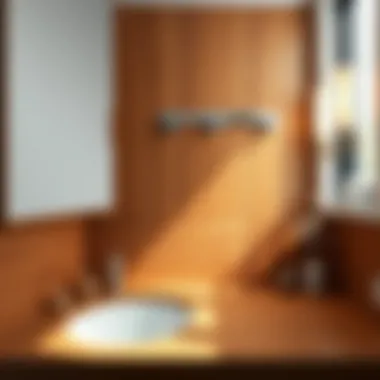
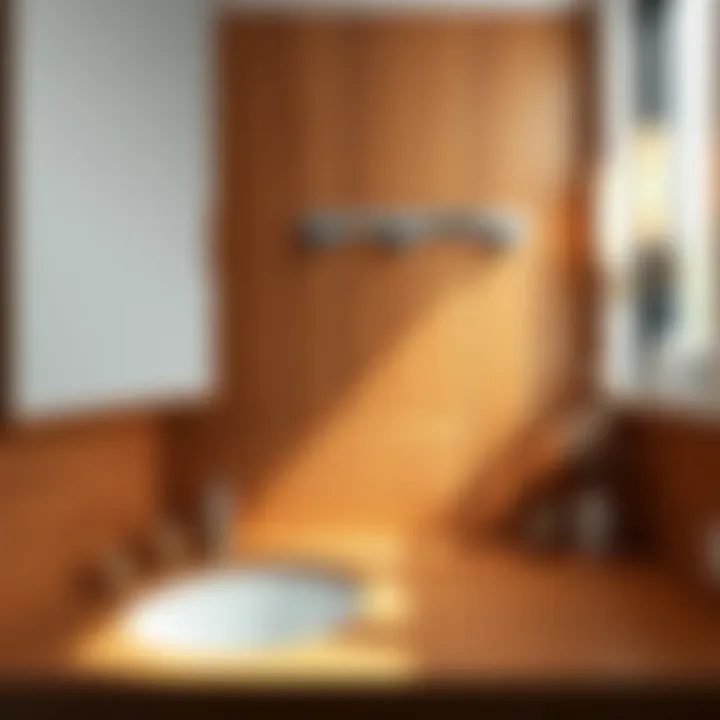
Consider incorporating subtle textures or soft tones into your minimalist backsplash to keep it visually interesting without deviating from the clean aesthetic. Minimalism encourages homeowners to focus on what truly matters in their bathroom environment.
Geometric Patterns
Geometric patterns have made a notable comeback, offering a visually stimulating option for those who enjoy a bit of flair in their spaces. From hexagons to chevrons, these patterns can add dynamism to an otherwise plain wall. Not just aesthetically pleasing, these designs can instill a modern touch, creating an eye-catching focal point behind sinks or vanities.
When selecting geometric tiles, consider colors that align with the overall theme of your bathroom. A navy blue hexagon against a white backdrop can provide a chic contrast while remaining sophisticated.
- Benefits of Geometric Patterns:
- Visually stimulating, breaking monotonous lines.
- Provides a trendy yet timeless look.
- Customizable; patterns can be mixed to suit personal style.
"A well-chosen pattern can automatically enhance the character of a space. A bathroom backsplash is no exception to this rule."
Embracing geometric patterns allows for creative expression while maintaining a balance of functionality and style.
Vintage Inspirations
The charm of vintage design cannot be overlooked. It exudes a timeless quality that many homeowners find appealing. Vintage-inspired backsplashes might include intricate ceramic tiles, colorful mosaics, or even reclaimed materials that tell a story. These choices elevate the visual interest and bring a warm, nostalgic feel to contemporary settings.
Incorporating vintage elements involves striking a balance between old-world charm and modern sensibilities. For instance, a beautifully detailed, patterned tile can serve as a statement piece above the sink.
- Reasons to Consider Vintage Inspirations:
- Adds character and historical context to the bathroom.
- Eco-friendly options if sourcing reclaimed materials.
- Creates a one-of-a-kind aesthetic, ensuring your bathroom doesn’t look like everyone else's.
Mixing vintage with modern fixtures can yield stunning contrasts that make your bathroom not only functional but a true reflection of your personal style. Vintage inspirations harmonize simplicity with intricacy, making them a favorite choice for many homeowners.
Combining Backsplash and Countertop Styles
When it comes to designing a bathroom, one of the most striking aspects is the relationship between the backsplash and the countertop. Creating a harmonious interaction between these two elements can serve as a delightful focal point. Not only does this alliance elevate the overall aesthetics, but it also enhances the functional aspects of the space, making it both inviting and practical.
The beauty of combining backsplash and countertop styles lies in the opportunity for creativity. Selecting the right materials and colors that complement each other can transform an ordinary bathroom into something visually stunning. For instance, pairing a sleek, white granite countertop with a vibrant mosaic backsplash can add a pop of color and texture, drawing the eye immediately to the area.
Moreover, the choice of design can set the mood for the entire room. A polished quartz countertop with a simple, understated tile backsplash can evoke a modern, clean atmosphere. On the other hand, a rich, wooden countertop might work better when matched with a colorful ceramic backsplash that adds warmth and a rustic charm, thereby establishing a cozy vibe.
Benefits of Consideration
- Visual Cohesion: Achieving a balanced look is essential. When the styles of the backsplash and countertop complement one another, the bathroom feels more coherent, even welcoming. A mismatch can cause confusion in style, making the design feel disjointed.
- Practicality: Choosing materials that work well together is not just about aesthetics. Consider the maintenance requirements of both surfaces. A highly polished countertop may require different cleaning techniques than a textured backsplash, leading to increased effort in upkeep.
- Highlighting Features: By understanding how to juxtapose or blend these elements, you can emphasize certain features. Using a contrasting backsplash can draw attention to a unique countertop shape or color, making the design intentional and thoughtful.
- Increased Resale Value: A well-designed bathroom, where the backsplash and countertop harmonize, can also catch the eye of potential buyers. When the bathroom feels like a well-thought-out space, it enhances market appeal and can possibly increase property value.
"Good design is in the details; the balance between a backsplash and countertop can tell the story of your entire bathroom design."
In essence, combining backsplash and countertop styles isn’t just an afterthought—it's an integral part of the design process that calls for thoughtful consideration. It's about creating a space that reflects personal style while also ensuring functionality and ease of maintenance.
Showcase of Notable Bathroom Designs
When it comes to bathroom designs, a backsplash can make or break the overall aesthetic of the space. This section dives into the theme of notable bathroom designs, underscoring how innovative backsplashes can transform an ordinary bathroom into a personal sanctuary. Not only do unique backsplashes enhance visual appeal, but they also serve practical functions, shielding walls from moisture and stains.
Incorporating notable bathroom designs into your home can boost creativity and inspire fresh ideas. It's about capturing that perfect blend of function and fashion. More than aesthetics, many homeowners are looking to set a trend or make a statement, and the right backsplash does just that. Here are the primary elements involved:
- Creativity and Inspiration: Stunning designs push boundaries. By showcasing innovative backsplashes, you explore unconventional materials—perhaps using recycled glass or bold patterns that wouldn’t typically be seen in a traditional bathroom.
- Functional Design Considerations: Practicality doesn’t have to compromise style. A well-thought-out backsplash can prevent water damage and mold build-up, ensuring that beauty meets longevity.
- Personal Touch: Homeowners appreciate personalizing their spaces. This can be done through color choices, design types, and even the textures chosen for the backsplash, making it a canvas for self-expression.
In this space, readers can also glean insights on how these notable designs can fit into different bathroom types—be it modern, rustic, or somewhere in between.
Modern Interpretations
Modern designs embrace sleek lines and minimalist aesthetics. For backsplashes, this means opting for materials and patterns that are visually striking but not overwhelming. In many instances, homeowners are turning to materials like quartz, which combines durability with a clean look. Here are some modern ideas:
- Geometric Patterns: Shaped tiles arranged in distinct patterns can be a real showstopper. Think three-dimensional designs or hexagonal shapes that add depth.
- Glass and Metal Combinations: Mixing materials can be striking. For instance, pairing glass tiles with metal accents brings a contemporary yet edgy vibe.
- Color Blocking: Using contrasting colors in a clever way can really elevate the design. It might be two-tone tiles or striking mosaics that draw the eye without overwhelming the senses.
These modern interpretations allow for versatility and creativity without veering into chaotic territory. The goal remains to create a space that feels harmonious and encourages relaxation.
Traditional Styles
Traditional designs take a more classic approach, often featuring natural materials that lend warmth and richness to a bathroom. Wooden backsplashes, for instance, can bring an organic touch while still being functional if sealed correctly. Here’s what you might see:
- Subway Tiles: These are timeless and versatile. White subway tiles installed in a herringbone pattern offer a fresh perspective while maintaining a classic look. Perfectly blended with dark grout, it can stand out without being too flashy.
- Stone Accents: Natural stone, such as slate or travertine, infuses a definitive elegance and durability into the space. It carries a weight that speaks to craftsmanship and history, making it ideal for traditional designs.
- Decorative Motifs: Consider detailing with intricate carvings or hand-painted tiles that tell a story, becoming a focal point. This adds character and personal flair to an otherwise simple backdrop.
Traditional style often leans toward consistency and timelessness as the focus, ensuring that the backsplash remains a lasting feature in the bathroom.
Budget Considerations for Backsplashes
When it comes to designing a bathroom, the phrase "you get what you pay for" rings particularly true when discussing backsplashes. They might seem like a minor component in the grand scheme but selecting the right backsplash can have a significant impact on both the looks and functionality of your space. First off, understanding your budget is crucial before diving into materials and designs. The key is balancing aesthetics with practicality—both beauty and budget must coexist to create a harmonious bathroom ambiance.
Cost-Effective Materials
Let’s talk about some wallet-friendly options that don’t skimp on style. Cost-effective materials can keep your finances in check while still lending that desired flair to your bathroom.
- Ceramic Tiles: Affordable and versatile, ceramic tiles are a go-to for many homeowners. They can be found in numerous colors and patterns, which means endless customization without breaking the bank.
- Vinyl Backsplashes: Vinyl can be a marvelous choice for those who seek something that’s not only cost-efficient but also easy to install. They come in various designs, mimicking the look of natural materials at a fraction of the price.
- Paint: This might sound too simplistic for some, but a well-applied layer of paint can serve as a stylish backsplash. Use specialized paint designed to handle moisture to ensure durability.
These options are great for anyone hoping to jazz up their space without emptying their pockets. In many cases, mixing different materials could yield a beautiful look without creating a financial strain.
Investing in Quality
While cutting costs is often a priority, one must also consider the value of investing in quality materials.
Here are several compelling reasons to lean towards higher-end materials, even on a tighter budget:
- Longevity: Opting for high-quality tiles made of natural stone or resilient glass may save you from needing replacements down the line. It's often said that quality over quantity is a rule worth following.
- Aesthetic Appeal: Premium materials tend to have a different visual impact. For instance, a beautifully crafted marble backsplash can elevate the entire bathroom, making it feel more luxurious rather than just functional.
- Ease of Maintenance: Quality materials often require less upkeep. Glass and stone, for example, can endure stains better than cheaper alternatives, saving you from regular scrubbing and upkeep.
Investing in quality doesn’t mean sacrificing your budget; it enables you to enjoy a timeless look that retains its charm for years.
The End
The conclusion of this exploration into bathroom counter backsplash ideas serves as a significant reflection on the value of thoughtful design choices in one of the most utilized spaces of a home. A backsplash is more than a mere decorative feature; it acts as a vital component that bridges the gap between functionality and aesthetics. In the bathroom, where water exposure is a daily reality, choosing the right backsplash material can prevent damage and ensure longevity.
By considering factors such as material selection, color coordination, and maintenance, homeowners can create a serene and inviting atmosphere that resonates with their personal style. The myriad options available today—from sleek glass to rustic wood—afford ample opportunity for creativity. It’s not just about following trends, but rather about designing a space that feels authentic and reflects individual tastes.
Key Considerations about Culmination:
- Functionality vs. Aesthetics: Homeowners should strive for a balance between how the backsplash performs and how it looks. A functional design can also be beautiful, and vice-versa.
- Long-term Investment: Quality materials may come with a higher upfront cost, but they often lead to lower maintenance and repair expenses in the long run.
- Personal Touch: Each bathroom can showcase unique characteristics, from playful colors to intricate patterns. This allows for a personal expression of style, making the bathroom feel more like a retreat.
- Cohesive Design: The backsplash should harmonize with other elements in the bathroom, including countertops, cabinetry, and fixtures. This unity creates a more sophisticated and intentional look.
In summary, the key takeaways from this article highlight the significance of the backsplash in enhancing not just functionality but also the aesthetic appeal of bathrooms. By making informed choices that consider both the practical and artistic aspects of design, homeowners can elevate their bathrooms into tranquil sanctuaries, ensuring that every detail contributes to a calming and inviting environment.
"A well-chosen backsplash can transform the ordinary into the extraordinary, making your bathroom a place of beauty and comfort."
For those eager to explore more about home decoration trends, check resources like Britannica for historical context, or join community discussions on platforms like Reddit.



